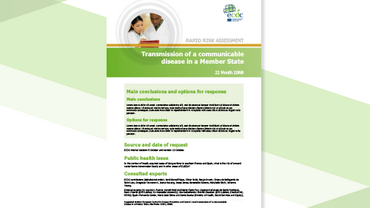Rapid risk assessment: Zika virus disease epidemic: potential association with microcephaly and Guillain–Barré syndrome - 5th update, 12 April 2016
This update assesses the risks associated with the Zika virus epidemic currently affecting countries in the Americas, taking account of the latest information available. It assesses the association between Zika virus infection and congenital central nervous system malformations, including microcephaly, as well as the association between Zika virus infection and the Guillain–Barré syndrome.
Executive Summary
The Zika epidemic in the Americas continues to evolve and expand geographically. Six additional countries or territories have reported laboratory-confirmed autochthonous transmission: the Philippines, Fiji, Vietnam, Kosrae (Federated States of Micronesia), Papua New Guinea and Cuba, in the past month.
Association of Zika virus to severe outcomes
The evidence in favour of a causal link between Zika virus infection during pregnancy and congenital central nervous system malformations is substantial and accumulating. There is ‘strong scientific consensus that Zika virus is a cause of Guillain-Barré syndrome (GBS), microcephaly and other neurological disorders based on observational, cohort and case–control studies currently published’, stated WHO on 31 March 2016.
The consistency of the parallel occurrence of Zika virus epidemic and severe outcomes in some of the affected countries indicate an increased likelihood of an association with Zika virus infection. In addition, a recent study documents that infectious Zika virus was isolated from human foetal brain, which supports the biological plausibility of the association between congenital Zika virus infection and foetal brain damage.
Mitigation options
Considering the continued spread of Zika virus in the Americas and Caribbean, the strong evidence of an association between Zika virus infection during pregnancy and congenital central nervous system malformations, the association between Zika virus infection and Guillain-Barré syndrome, and the risk of establishment of local vector-borne transmission in Europe during the 2016 summer season, EU/EEA Member States are recommended to consider a range of mitigation measures.
The risk assessment provides updated or reiterated options for mitigation for the Member States, mainly related to information for pregnant women and sexual transmission.







